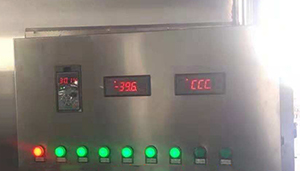Why blast air quick freezer is recommended?
During slow freezing, ice crystals grow in intercellular spaces and deform and rupture adjacent cell walls. Ice crystals have a lower water vapor pressure than regions within the cells, and water therefore moves from the cells to the growing crystals. Cells become dehydrated and permanently damaged by the increased solute concentration and a collapsed and deformed cell structure. On thawing, cells do not regain their original shape and turgidity.
In fast freezing, smaller ice crystals form within both cells and intercellular spaces. There is little physical damage to cells, and water vapor pressure gradients are not formed; hence there is minimal dehydration of the cells. The texture of the food is thus retained to a greater extent. However, very high freezing rates may cause stresses within some foods that result in splitting or cracking of the tissues.
Benefit and Drawback of Various Quick Freezing Equipment
Tunnel air blast quick freezer
In this blast quick freezers, air is recirculated over food at between -30℃ and -40℃ at a velocity of 1.5–6.0 m s-1. The high air velocity reduces the thickness of boundary films surrounding the food and thus increases the surface heat transfer coefficient.
Continuous air blast quick freezing equipment consists of conveyor mesh belts which carry the food through an insulated tunnel. Blast freezing is relatively economical and highly flexible in that foods of different shapes and sizes can be frozen. The equipment is compact and has a relatively low capital cost and a high throughput (200–1500 kg h-1).
However, moisture from the food is transferred to the air and builds up as ice on the refrigeration coils, and this necessitates frequent defrosting. The large volumes of recycled air can also cause dehydration losses of up to 5%, freezer burn and oxidative changes to unpackaged or individually quick frozen (IQF) foods.
Fluidized Quick-Freezer
Fluidised-bed freezers are modified blast freezers in which air at between -25℃ and -35℃ is passed at a high velocity (2–6 m s-1) through a 20–130 mm bed of food, contained on conveyor mesh belt. The shape and size of the pieces of food determine the thickness of the fluidised bed and the air velocity needed for fluidisation. Food comes into greater contact with the air than in blast freezers, and all surfaces are frozen simultaneously and uniformly. This produces higher heat transfer coefficients, shorter freezing times, higher production rates (10,000 kg h-1) and less dehydration of unpackaged food than blast freezing does. The equipment therefore needs less frequent defrosting. However, the method is restricted to particulate foods, for example peas, sweetcorn kernels, shrimps, strawberries or French fried potatoes.
Spiral Quick Freeze Machine
Spiral Belt freezers have a continuous flexible mesh belt which is formed into spiral tiers and carries food up through a refrigerated chamber. Cold air is directed down through the belt stack, which reduces weight losses due to evaporation of moisture. Spiral freezers require relatively small floor-space and have high capacity, for example a 500–750 mm wide belt in a 32-tier spiral processes up to 3000 kg h-1. Other advantages include automatic loading and unloading, low maintenance costs and flexibility to freeze a wide range of foods including pizzas, cakes, pies, ice cream, whole fish and chicken portions.




